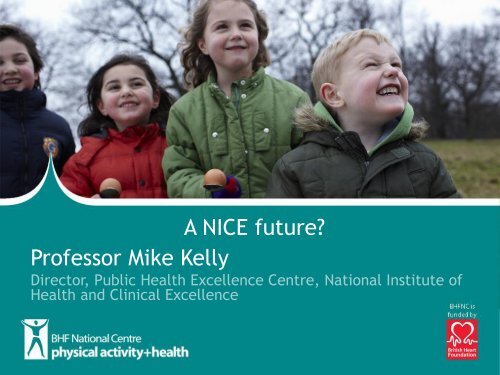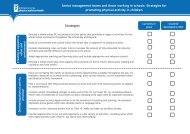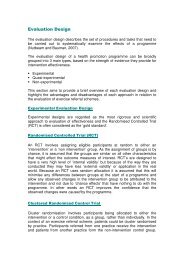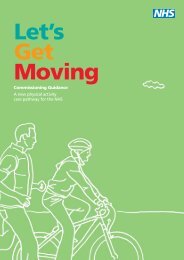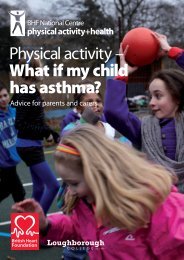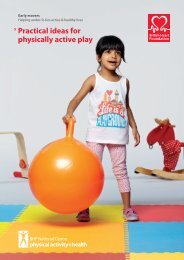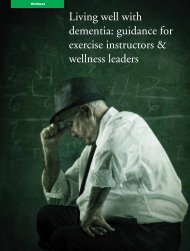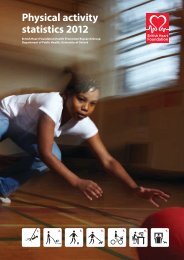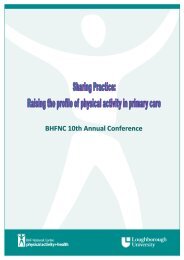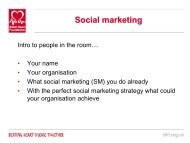A NICE future? - BHF National Centre - physical activity + health
A NICE future? - BHF National Centre - physical activity + health
A NICE future? - BHF National Centre - physical activity + health
Create successful ePaper yourself
Turn your PDF publications into a flip-book with our unique Google optimized e-Paper software.
A <strong>NICE</strong> <strong>future</strong>?<br />
Professor Mike Kelly<br />
Director, Public Health Excellence <strong>Centre</strong>, <strong>National</strong> Institute of<br />
Health and Clinical Excellence
<strong>NICE</strong> published work on Physical<br />
<strong>activity</strong><br />
• Four commonly used methods to promote <strong>physical</strong><br />
<strong>activity</strong> (2006) PH2<br />
• Physical Activity and the Environment. PH8<br />
• Physical Activity in children and young people. PH17<br />
• Physical <strong>activity</strong> in the workplace. PH13
Four commonly used methods to<br />
promote <strong>physical</strong> <strong>activity</strong> (2006) PH2<br />
• Partial update now underway.<br />
• Physical <strong>activity</strong> advice in primary care (publish April<br />
2013)<br />
• Consultation 4 th November till 2 nd December<br />
• Brief advice to promote <strong>physical</strong> <strong>activity</strong><br />
• Local infrastructure and systems that facilitate the<br />
delivery of brief advice
• <strong>NICE</strong> will reconsider the need to update the<br />
recommendations on exercise referral, following<br />
publication of the <strong>health</strong> technology assessment (HTA)<br />
review „The clinical and cost effectiveness of exercise<br />
referral schemes: a systematic review<br />
• <strong>NICE</strong> is developing new guidance on local measures<br />
to promote walking and cycling which will include an<br />
update of the recommendations on pedometers and<br />
walking and cycling schemes.
Timetable<br />
• Physical Activity and the Environment. PH8 review Feb<br />
2014<br />
• Physical Activity in children and young people. PH17<br />
update 2012<br />
• Physical <strong>activity</strong> in the workplace. PH13 review July<br />
2014
Walking and Cycling<br />
• <strong>health</strong> impacts of increasing walking and cycling<br />
• wider environmental and economic impacts arising from<br />
promoting walking and cycling as a form of travel (for<br />
instance, a reduction in carbon emissions or<br />
congestion).
Local government public <strong>health</strong><br />
briefings<br />
• New audience<br />
• New responsibilities<br />
• New products
The Dual Process system.<br />
• The reflective system.<br />
– Reflective, goal oriented system driven by our values<br />
and intentions requiring cognitive capacity or thinking<br />
space, which is limited.<br />
– Many traditional approaches to <strong>health</strong> promotion<br />
depend on engaging this system.<br />
– Often based on providing information designed to<br />
alter beliefs and attitudes, motivate people with the<br />
prospect of <strong>future</strong> benefits, or help them develop self<br />
regulatory skills.<br />
– At best, these approaches have been modestly<br />
effective in changing behaviour.
• The automatic, affective system that requires little or no<br />
cognitive engagement, being driven by immediate<br />
feelings and triggered by our environments.<br />
• This automatic system is the focus of nudge theory.
Dual process model of human<br />
behaviour<br />
Focus of many<br />
“traditional” <strong>health</strong><br />
promotion/education<br />
interventions; e.g.<br />
Provision of<br />
information. BUT “at<br />
best, these<br />
approaches have been<br />
modestly effective in<br />
changing behaviour”1<br />
Human actions governed by<br />
Reflective/<br />
deliberative/<br />
rational<br />
processes<br />
Automatic/nonconscious/nondeliberative<br />
processes<br />
Deliberative<br />
behaviours<br />
(acting upon<br />
reflective<br />
process)<br />
Involuntary<br />
cognitions,<br />
emotions and<br />
behaviours<br />
(behavioural<br />
impulses)<br />
“I want to lose<br />
weight – I will eat<br />
<strong>health</strong>ily.”<br />
Eating <strong>health</strong>ily – less<br />
high fat foods, more<br />
vegetables, etc<br />
Grab a chocolate bar,<br />
it’s right in front of me.<br />
1: BMJ 2011; 342:d228
Choice Architecture<br />
http://pumabydesign001.wordpress.com/2010/10/07/michael-bloomberg%E2%80%99s-agenda-tonudge-new-yorkers-using-food-stamps/
Changing behaviour through influencing automatic<br />
mechanisms<br />
Human actions governed<br />
by<br />
Reflective/<br />
deliberative/<br />
rational<br />
processes<br />
Automatic/nonconscious/nondeliberative<br />
processes<br />
Non-conscious<br />
activation of<br />
schema<br />
Sensory Information<br />
e.g. situational and<br />
environmental cues<br />
Choice<br />
architecture: “the<br />
environment in which<br />
an individual makes a<br />
decision”2<br />
Involuntary<br />
cognitions,<br />
emotions and<br />
behaviours<br />
(behavioural<br />
impulses)<br />
2: House of Lords Science and Technology Select Committee. 2nd Report of Session 2010–12 .Behaviour Change.<br />
3: Nudge: Improving Decisions about Health, Wealth, and Happiness. Richard Thaler and Cass Sunstein. 2008.
• MARTEAU, T.M., OGILVIE, D., ROLAND, M.,<br />
SUHRCKE, M., KELLY, M.P. (2011) Judging nudging:<br />
can „nudging‟ improve population <strong>health</strong>? British<br />
Medical Journal.


